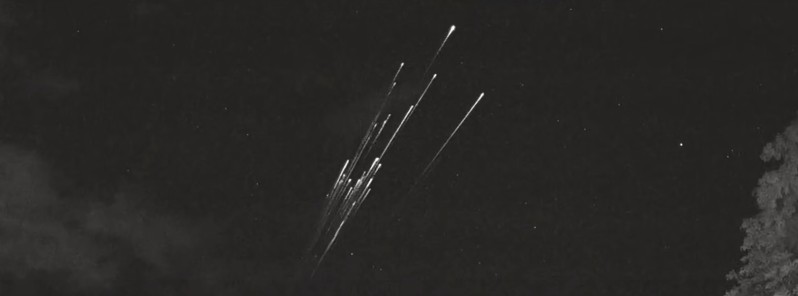Starlink satellites falling from the sky caught on videos

Starlink satellites are falling from the sky after a G1 – Minor geomagnetic storm hit Earth just a day after they were launched from Kennedy Space Center in Florida on February 3, 2022. Preliminary analysis shows that the storm caused significantly increased atmospheric drag and prevented satellites from leaving safe-mode.
According to SpaceX, 49 Starlink satellites were launched and all of them were successfully deployed into their intended orbit, achieving controlled flight. The company deploys its satellites into lower orbits so that in the very rare case any satellite does not pass initial system checkouts it will quickly be deorbited by atmospheric drag to maintain a sustainable space environment.
"Unfortunately, the satellites deployed were significantly impacted by a geomagnetic storm," SpaceX said in an update. "These storms cause the atmosphere to warm and atmospheric density at our low deployment altitudes to increase.
"In fact, onboard GPS suggests the escalation speed and severity of the storm caused atmospheric drag to increase up to 50 percent higher than during previous launches. Preliminary analysis shows the increased drag at the low altitudes prevented the satellites from leaving safe-mode to begin orbit raising maneuvers, and up to 40 of the satellites will reenter or already have reentered the Earth’s atmosphere.
"The deorbiting satellites pose zero collision risk with other satellites and by design demise upon atmospheric reentry—meaning no orbital debris is created and no satellite parts hit the ground. This unique situation demonstrates the great lengths the Starlink team has gone to ensure the system is on the leading edge of on-orbit debris mitigation."
The Sociedad de Astronomia del Caribe caught one of the re-entries over Puerto Rico on February 7:

"I did astrometry on the Puerto Rico sighting, and the orbital inclination fits the 53.2 degrees of the Starlink launch. My best guess still remains that this was one of the failed Starlink satellites from February 3," said Marco Langbroeg, a satellite tracking expert from the Netherlands.
The second shows a fireball seen from Spain at about 20:50 UTC on February 10, 2022, recorded and studied in the framework of SMART project. This fireball was also generated as a consequence of the re-entry of a Starlink satellite with a mass of about 260 kg (573 miles).
According to the analysis made by the principal investigator of the SMART project, Dr. Jose M. Madiedo, this satellite was launched by SpaceX on October 6, 2020.
A wide number of causal eyewitnesses could see the phenomenon, Madiedo said.
"The reentry took place at about 23 000 km/h. This gave rise to a fireball which began at a height of around 95 km [59 miles] over the province of La Coruña (region of Galicia, northwest of Spain) and moved southeast, crossing the Iberian Peninsula and the Mediterranean Sea. It ended over Algeria."


More than 2 000 Starlink satellites have been launched as of February 2022. The satellites form a constellation that provides new generation of satellite internet.
Using advanced satellites in a low orbit, Starlink enables video calls, online gaming, streaming, and other high data rate activities that historically have not been possible with satellite internet, SpaceX said. Users can expect to see download speeds between 100 Mb/s and 200 Mb/s and latency as low as 20ms in most locations.
Featured image: Sociedad de Astronomia del Caribe (SAC)

Commenting rules and guidelines
We value the thoughts and opinions of our readers and welcome healthy discussions on our website. In order to maintain a respectful and positive community, we ask that all commenters follow these rules:
We reserve the right to remove any comments that violate these rules. By commenting on our website, you agree to abide by these guidelines. Thank you for helping to create a positive and welcoming environment for all.